Material Sciences
Vol.
11
No.
11
(
2021
), Article ID:
46395
,
10
pages
10.12677/MS.2021.1111134
稀土单原子钇(Y)吸附对锐钛矿TiO2薄膜光催化活性的影响
伊力哈尔·艾散,甫尔开提·夏尔丁*,买买提热夏提·买买提,王青
新疆大学物理科学与技术学院,新疆 乌鲁木齐
收稿日期:2021年10月9日;录用日期:2021年11月4日;发布日期:2021年11月11日

摘要
本文采用基于密度泛函理论(DFT)的第一性原理计算方法,研究了稀土单原子钇(Y)吸附对锐钛矿薄膜TiO2光催化活性的影响。由于钇原子向锐钛矿TiO2 (101)表面的电荷转移,吸附表面的功函数明显小于纯表面的功函数,表明表面活性增强。钛原子的3d轨道作为杂质能级出现在导带底,变成浅能级,通过缩小带隙来增强光吸收率。当单钇原子被吸附时,表面Ti原子的势能接近于真空能级,显著促进了电子的转移,从而促进了氢的产生。在被激发的TiO2光催化剂中,光诱导电子可以通过表面钛原子转移到目标物种,意味着电子–空穴对能有效地分离而提高光催化活性。此外,由于钇原子的吸附,导带边缘的上移将提高锐钛矿TiO2的还原能力。本研究结果为单金属原子吸附提高光催化性能提供了新的思路。
关键词
单原子吸附,锐钛矿薄膜(101)表面,活性位点,杂质能级,光吸收率,光催化活性

Influence of Rare Earth Single-Atom Yttrium (Y) Adsorption on the Photocatalytic Activity of TiO2 Thin Film
Yilihar Aisan, Fuerkaiti Xiaerding*, Mamatrishat Mamat, Qing Wang
School of Physics and Technology, Xinjiang University, Urumqi Xinjiang
Received: Oct. 9th, 2021; accepted: Nov. 4th, 2021; published: Nov. 11th, 2021

ABSTRACT
The effect of single rare earth atom (Y) adsorption on the photocatalytic activity of anatase TiO2 thin film was studied by the first-principles calculation based on density functional theory (DFT). Due to the charge transfer of yttrium atom to anatase TiO2 (101) surface, the work function of the adsorbed surface is significantly smaller than that of the pure surface, indicating that the surface activity is enhanced. The 3d orbital of titanium atom appears as an impurity energy level at the bottom of the conduction band, becoming a shallow energy level and enhancing the optical absorption rate by narrowing the band gap. When the single yttrium atom is adsorbed, the potential energy of the surface Ti atom is close to the vacuum level, which significantly promotes electron transfer and thus hydrogen production. In the excited TiO2 photocatalyst, the photoinduced electrons can be transferred to the target species via the surface titanium atom, meaning that the electron-hole pair can be effectively separated to improve the photocatalytic activity. In addition, due to the adsorption of yttrium atom, the upward shift of the conduction band edge will improve the reduction ability of anatase TiO2. The results of this study provide a new idea for improving the photocatalytic performance of single metal atom adsorption.
Keywords:Single-Atom Adsorption, Anatase Thin Film (101) Surface, Active Site, Impurity Level, Optical Absorption, Photocatalytic Activity

Copyright © 2021 by author(s) and Hans Publishers Inc.
This work is licensed under the Creative Commons Attribution International License (CC BY 4.0).
http://creativecommons.org/licenses/by/4.0/


1. 引言
自然资源的长期过度开发和利用,导致能源和原材料的不足。为应对能源危机问题,科研工作者对各种诸如风能、核电、太阳能能源做出了深入研究。在这一背景下,半导体光催化材料在太阳能电池、光催化污染物分解与光解水制氢相关的光电转换和能源领域得到了广泛的关注和探索 [1] [2]。Kazuhito Hashimoto [3] 等从科学和技术的角度综述了TiO2光催化技术的发展及其未来前景。在被研究的各种光催化剂中,二氧化钛是一种具有独特光催化性能的令人着迷的材料,由于其对有机污染物的强氧化分解能力、化学稳定性、耐久性长、无毒和低成本,在许多技术应用中得到了开发 [4] [5] [6]。由于其宽带隙,它仅在紫外线照射下才具有活性,这限制了其光催化效率 [7]。
为了改善TiO2以上叙述的缺点,而使其得到广泛的应用,在理论计算上,根据密度泛函理论(Density Functional Theory, DFT)的自冾计算来确定材料的几何结构、电子结构、光学、磁学和热学性质等材料物性 [8] [9]。科研工作者基于DFT计算采用离子掺杂 [10] - [15]、贵金属负载、表面敏化 [16] [17] [18] [19] [20]、半导体复合材料 [21] [22] 等各种改性和修饰方法来提高光催化活性及获得太阳能利用率的实验手段无法得到的信息,但是采用表面吸附的研究工作很少 [23] [24] [25]。
由于金属纳米结构对各种重要化学反应具有较高的活性和选择性,因此被广泛应用于多相催化剂。被吸附的金属催化剂是不均匀的,通常由具有广泛粒径分布和不规则形貌的金属颗粒组成。每种金属颗粒都可能呈现不同的活性位点,具有不同的催化性能。因此,这种不均一性严重影响了金属活性位点的有效利用,进而降低了特定催化过程的选择性 [26]。单原子吸附可以实现大幅度的成本还原、高的催化活性和选择性。
利用太阳能分解水,利用无机半导体辅助制氢,是发展清洁能源技术的关键。最近,Xing等人在实验上成功地合成了孤立金属原子稳定吸附的锐钛矿TiO2 (101)表面结构,将单原子催化剂的概念引入光催化制氢领域。研究报告表明吸附单金属原子的锐钛矿TiO2 (101)表面比纯锐钛矿TiO2 (101)表面具有更高的氢吸附能力,这有利于光催化产氢的催化活性 [27]。锐钛矿TiO2 (101)表面一般具有较好的热力学稳定性 [27]。本文中,考虑钇(Y)化学性质(还原性强),探讨Y吸附在锐钛矿TiO2 (101)表面上,从光催化制氢的基本结构和电子性质出发,重点研究了光催化制氢的活性位点和还原能力,揭示了光催化高效制氢的潜在机理。
2. 计算方法
本工作中,使用MS软件包中的CASTEP模块,在几何优化和性能计算中采用自旋极化(GGA + PW91) + U (U = 2.5 eV)方法。该计算中交换相关函数的广义梯度近似(GGA-PW91)的Perdew-Wang (PW91)被采用。采用超软赝势,截断能和对钛3d轨道的U值参数分别为300和2.5 eV。用G中心的k点网格2 × 3 × 1对平板模型晶胞的布里渊区进行采样,对电子性质计算用的k点网格为4 × 4 × 1。单原子Y吸附的锐钛矿膜(101)晶胞的2 × 2表面构建周期性平板模型,并将真空设置为15 Å。该模型包含四层O-Ti-O,因此由48个原子组成。锐钛矿TiO2 (101)表面包含的离子:2配位的O原子(O2c),5配位的Ti原子(Ti5c),3配位的O原子(O3c)和6配位的Ti原子(Ti6c)。当单个原子吸附在2 × 2锐钛矿TiO2表面上时,Y元素覆盖率为0.25 ML。Y,Ti和O的价电子数分别为3,12和6。当两个底层的原子冻结在其本体位置时,允许平板的剩余活性面弛豫,并且向底层通过加氢进行钝化。最小化算法是Broyden Fletcher-Goldfarb-Shanno (BFGS)方案,通过最小化总能量和原子力来优化原子坐标以获得准确的结果。在几何优化中,所有作用于原子的力收敛到0.05 eV/Å,总能量的收敛阈值设置为0.0001 eV。
3. 结果与讨论
3.1. 表面吸附结构
如表1所示,本研究计算出来的体块晶格常数与实验值 [28] [29] 十分接近,表明本计算结果的可靠性,可进一步进行后续的计算。
Table 1. Lattice constants of anatase TiO2 and their differences from experimental measurements
表1. 锐钛矿TiO2的晶格常数及其与实验测量的差异
纯锐钛矿薄膜(101)表面的氧原子是配位不饱和的(如图1(a)所示),并且Y原子的还原性较强,所以容易吸附于表面沿着[010]方向的两个O2c原子之间的桥接位置(如图1(b)所示),形成金属氧化物一样的化学键,它与O2c原子之间的键长约为2Å (如表2所示),与先前的结果相似 [30] [31] [32]。
吸附能经常被用来分析晶体结构的稳定性,其计算公式如下 [24]:
(1)
式中 与 表示稀土原子被吸附前后TiO2体系的总能量;EY表示稀土原子基态能量。式(1)表示稀土原子吸附前后系统的能量差。当E△ 值为负值时,对应放热吸附,即负值的绝对值越大,吸附体系就越稳定。当E△值为正数值时,吸附体系不能稳定存在。如表2所示,吸附能远小于零,说明吸附结构是非常稳定。
由于在界面区域的电荷转移,在氧化物半导体表面上的吸附原子总是引入表面偶极矩 [33]。然后,通过电偶极子和界面电荷的重新分布来改变表面功函数 [27]。功函数的大小表示表面失去电子的难度。钇–锐钛矿(101)表面吸附结构的功函数跟纯表面功函数大小比起来小得多,功函数越小,表面越容易失去电子,说明表面还原性变强,有利于有效地分解污染物。
 (a) (b)
(a) (b)
Figure 1. Structural model: (a) The slab of the pure anatase TiO2 (101) plane after structure optimization; (b) Structural model of yttrium-anatase (101) surface adsorption structure. Red and gray spheres represent O and Ti atoms, respectively
图1. 结构模型:(a) 结构优化后的纯锐钛矿(101)表面平板模型;(b) 钇–锐钛矿(101)表面吸附结构的结构模型。红色和灰色的球体分别代表O和Ti原子
Table 2. Average bond length of four Ti-O bonds (two Ti6c-O2c and two Ti5c-O2c), average bond length value of Y-O2c bond, adsorption energy, average Hirshfeld Charge of four Ti ions (two Ti6cand two Ti5c), surface work function (experimental value 7.20 eV) and average charge Population of Ti-O bond
表2. 四个Ti-O键(两个Ti6c-O2c和两个Ti5c-O2c)的平均键长度,Y-O2c键的平均键长度值,吸附能,四个Ti离子(两个Ti6c和两个Ti5c)平均Hirshfeld 电荷,表面功函数(实验值为7.20 eV)和Ti-O键的平均电荷布局(Population)
被吸附原子与锐钛矿TiO2表面之间的电荷转移量同样能反映吸附系统的稳定性。为了表征在锐钛矿TiO2 (101)表面吸附单原子Y时的电荷重新分布性质,采用以下公式来计算电荷密度差
(2)
其中,Ptotal为整个吸附体系的电荷密度, 和PY分别表示锐钛矿TiO2表面和单个Y的电荷密度。图2显示了由单原子Y吸附在锐钛矿TiO2 (101)表面上引起的电荷密度差。可知电荷从被吸附的单原子Y转移到锐钛矿TiO2 (101)表面,说明Y原子被稳定地吸附于锐钛矿TiO2 (101)表面。大量的电子积聚在界面区域,Ti离子上都有电子集中,说明由Y向表面输入的电子可以被转移到Ti离子上去,使表面钛原子还原。这刚好与Ti离子Hirshfeld电荷值的变小符合,Ti离子Hirshfeld电荷值越小,表面向Ti离子上转移的电子越多。电荷密度差和Hirshfeld电荷值可知使用U (U = 2.5 eV)参数来而激活的Ti离子能蒱获更多的电子。此外,从Ti-O键的平均电荷布局得知Ti-O键强度变弱,因为平均电荷布局越小,键的共价键性越弱。说明因为Ti离子获得电荷引起它和O离子之间产生排斥力,导致Ti-O键强度变弱,所以相应的键长变大,同时把O3c离子往上推(如图1(b)所示)。正因为以上的原因吸附结构表面的凹凸不平程度和还原性变强,有利于污染物与表面的有效接触,容易进行化学反应来达到分解污染物的目的。
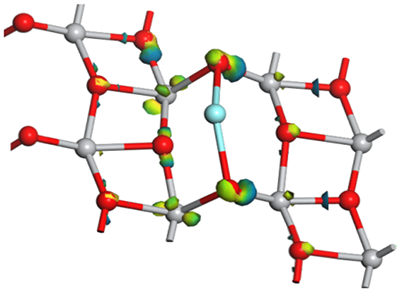
Figure 2. Charge density difference for single Y atom adsorption on anatase TiO2 (101) surface. The cyan region represents charge depletion and the yellow region represents charge accumulation. The isosurface value is 0.2 e/Å3. The red and gray spheres represent O and Ti atoms, respectively, and the metal atoms are denoted
图2. 锐钛矿TiO2 (101)表面单原子Y吸附的电荷密度差。蓝色和黄色区域分别代表电荷耗尽和电荷积聚。等值面值为0.2 e/Å3。红色和灰色球分别代表O和Ti原子
3.2. 电子结构
如图3所示,计算得到的锐钛矿(101)表面的计算带隙值为3.049 eV,与锐钛矿薄膜(101)表面实验值3.050 eV十分接近。吸附Y原子后锐钛矿(101)表面能带的能级密度变大,有利于电子的顺利移动,帮助光诱导电子–空穴对的有效分离。此外,能级密度变大正好促进由Y原子向表面输入的电子转移到Ti离子上去。能带结构导带底出现浅能级,带隙宽度变小为2.407 eV,将会导致光吸收率的有所提高。
图4(a)所示,纯锐钛矿的价带和导带分别主要由O原子2p轨和Ti原子3d轨道组成,与先前的结果一致 [34]。很明显,刚好在费米能级以下出现了Ti原子3d轨道态(图4(b)所示,零点能级为费米能级),说明Ti离子捕获电子能力增强了,验证了3.1节所得出的结论。
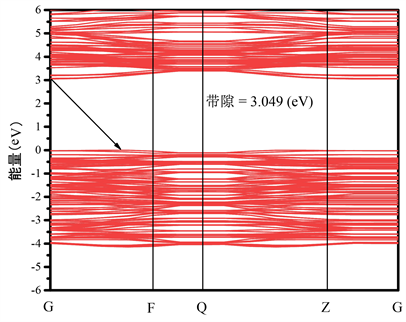 (a)
(a) (b)
(b)
Figure 3. Energy band structure, the abscissa is the geometrically highly symmetrical point in inverted lattice space, and the ordinate is the energy: (a) Surface band structure of pure anatase thin film (101); (b) Surface band structure of anatase thin film (101) adsorbed with single Y atoms
图3. 能带结构,横坐标为倒格空间中的几何高对称点,纵坐标为能量:(a) 纯锐钛矿薄膜(101)表面能带结构;(b) 吸附单Y原子的锐钛矿薄膜(101)表面能带结构
正因为Y原子的强还原能力由它向表面输入的电子也会跑到表面Ti离子上去,我们进一步研究了直接参与光催化过程的最上层表面Ti原子的电势变化。图4(c)所示显示了单Y原子吸附锐钛矿型TiO2 (101) 表面的最上表面Ti-3d轨道的PDOS变化,变化值为0.47 eV,为了便于比较原子势能,以真空能级为参考,将其设为零,与纯表面的相比非常明显,最顶部表面的Ti原子的势能变得更接近真空能级。与真空能级越接近,Ti原子的还原能力越高。所以最上层的表面Ti原子在光催化过程中也起到了还原位点的作用,更重要的是光诱导电子可以通过表面钛原子转移到目标物种,表面电子-空穴对能有效地分离来提高光催化活性。光催化产氢过程中也会起着重要作用。
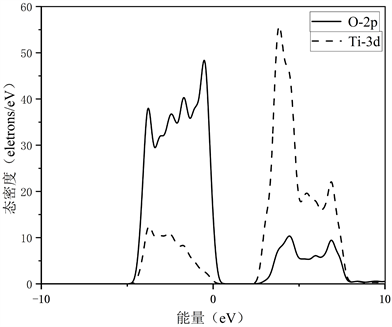 (a)
(a)
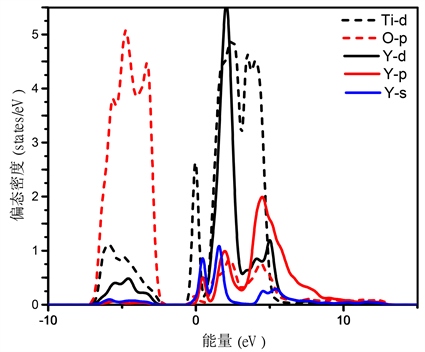 (b)
(b)
 (c)
(c)
Figure 4. Density of states: (a) PDOS of the pure anatase thin film (101) Surface; (b) four Ti ions (two Ti6c and two Ti5c) and four O ions (two O2c and two O3c) closest to the Y atom on the surface of anatase film (101), including the Y atom itself, PDOS of the nine surface atoms; (c) comparison of 3d orbital PDOS positions of surface Ti ions with adsorption structure and pure surface structure, and the vertical dashed lines represent the Fermi level
图4. 态密度:(a) 纯锐钛矿薄膜(101)表面PDOS;(b) 锐钛矿薄膜(101)表面上离Y原子最近的四个Ti离子(两个Ti6c和两个Ti5c)和四个O离子(两个O2c和两个O3c),包括Y原子本身,一共九个表面原子的PDOS;(c) 吸附结构和纯表面结构的表面Ti离子3d轨道 PDOS位置对比,划线指费米能级
导带顶(CBM)的电位越正,还原能力越强,价带底(VBM)电位越负,氧化能力越强 [35]。为了比较纯表面和不同吸附结构的带边位置,我们将真空能级设为零。纯锐钛矿TiO2 (101)表面的带边位置与前人的结果一致 [36]。相对于纯表面,Y原子吸附结构CBM的电位有所提高了,变化值为0.47 eV,导致光诱导电子的还原能力变强。
对应的得到同样的VBM电位变化趋势,但是它的氧化能力变弱。体块锐钛矿TiO2的CBM电位水平略高于氢还原电位(H+/H2)。所以吸附Y原子后还原能力增强的锐钛矿(101)表面具有在实验中用于产氢的潜力。
3.3. 光吸收
为了进一步验证前节的结论和证明光吸收率和光催化活性的提高,我们计算了纯和吸附体系的紫外-可见光吸收光谱,如图5所示。纯锐钛矿TiO2由于带隙宽,只能吸收紫外光。基于光催化水分解的原理,光催化剂的带隙能(Eg)应该大于1.2 eV才能实现水分解,但要有效地使用可见光(波长:400~780 nm,占日光的43%),Eg必须小于3.0 eV [37]。Y原子被吸附后,通过改变能带组成和在带隙中引入作为杂质能级的Ti离子3d轨道能级缩小了带隙宽度,太阳能吸收边将从紫外光向可见光区域延伸,导致吸收边红移。吸收光谱与吸附体系的能带隙相关,禁带更窄,吸收光谱有更多的红移。吸附体系的带隙为2.407 eV,所以吸收率比纯锐钛矿(101)表面吸收率大。从475 nm开始向可见光区域延伸,导致吸收边红移,并且相应的光催化活性也会有大幅度的提高。
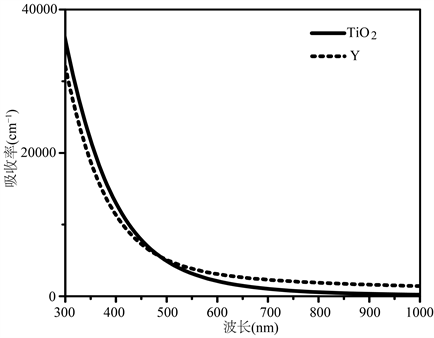
Figure 5. Uv-vis absorption spectra of pure and adsorbed structures
图5. 纯和吸附结构的紫外–可见吸收光谱
4. 结论
综上所述,探讨对吸附单Y原子的锐钛矿薄膜TiO2 (101)表面的电子性质进行了较全面的DFT。Y原子向锐钛矿TiO2 (101)表面输入大量的电荷,大量的集中在表面Ti原子上,使它还原。因此,Y原子的吸附显著降低了表面功函数,表明电子注入增强了表面活性。被激活的表面Ti原子可以有效地分离光致电子–空穴对,同时它的3d轨道作为杂质浅能级来缩小带隙,提高光吸收率。值得注意的是,吸附结构导带边缘向上移动,表面它的还原性变强。当单Y原子被吸附时,表面最上层Ti原子的势能变得接近真空水平,极大地促进了电子的转移,有利于产氢。因此,单原子光催化剂体系具有较高的产氢能力。
致谢
本工作致谢新疆自治区自然科学计划(自然科学基金)联合基金项目(No.2021D01C037)。
文章引用
伊力哈尔•艾散,甫尔开提•夏尔丁,买买提热夏提•买买提,王 青. 稀土单原子钇(Y)吸附对锐钛矿TiO2薄膜光催化活性的影响
Influence of Rare Earth Single-Atom Yttrium (Y) Adsorption on the Photocatalytic Activity of TiO2 Thin Film[J]. 材料科学, 2021, 11(11): 1155-1164. https://doi.org/10.12677/MS.2021.1111134
参考文献
- 1. 周诗文. 掺杂二氧化钛可见光催化活性的密度泛函研究[D]: [博士学位论文]. 长沙: 湖南大学, 2016.
- 2. 林俏露. 本征缺陷与Cu离子注入对单晶TiO2及ZnO磁性的影响[D]: [博士学位论文]. 兰州: 兰州大学, 2019.
- 3. Hashimoto, K., Irie, H. and Fujishima, A. (2005) TiO2 Photocatalysis: A Historical Overview and Future Prospects. Japanese Journal of Applied Physics, 44, 8269-8285. https://doi.org/10.1143/JJAP.44.8269
- 4. Choe, S.H., Yu, C.J., Ri, K.C., Kim, J.S., Jong, U.G., Kye, Y.H. and Hong, S.N. (2019) First-Principles Study of NaxTiO2 with Trigonal Bipyramid Structures: An Insight into Sodium-Ion Battery Anode Applications. Physical Chemistry Chemical Physics, 21, 8408-8417. https://doi.org/10.1039/C9CP00267G
- 5. Singh, S. and Tripathi, M.N. (2017) Electronic Structure and Optical Properties of Prominent Phases of TiO2: First- Principles Study. Pramana—Journal of Physics, 89, 5-10. https://doi.org/10.1007/s12043-017-1400-5
- 6. 孙桂鹏. 掺杂及空位缺陷对SnO2和TiO2光电性能的影响[D]: [博士学位论文]. 烟台: 鲁东大学, 2016.
- 7. Li, X., Shi, J., Chen, H., Wan, R., Leng, C., Chen, S. and Lei, Y. (2017) A DFT Study on the Modification Mechanism of (Cr, C) Co-Doping for the Electronic and Optical Properties of Anatase TiO2. Computational Materials Science, 129, 295-303. https://doi.org/10.1016/j.commatsci.2016.12.029
- 8. 李健, 周勇. 蜜度泛函理论[M]. 北京: 国防工业出版社, 2014: 1-31.
- 9. 谌祺, 郭瑞强, 张黎楠, 夏卫生. 材料缺陷的先进计算-电子结构方法[M]. 北京: 国防工业出版社, 2015: 57-97.
- 10. Bai, Y., Zhang, Q., Zheng, F., Yang, Y., Meng, Q., Zhu, L. and Wang, B. (2017) First-Principles Study on Co-Doping Effect to Enhance Photocatalytic Activity of Anatase TiO2. International Journal of Modern Physics B, 31, 37-48. https://doi.org/10.1142/S0217979217500369
- 11. Muhammady, S., Nurfani, E., Kurniawan, R., Sutjahja, I.M., Winata, T. and Darma, Y. (2017) The Effect of Ta Dopant on the Electronic and Optical Properties of Anatase TiO2: A First-Principles Study. Materials Research Express, 4, Article ID: 024002. https://doi.org/10.1088/2053-1591/aa5733
- 12. Ren, D., Li, H. and Cheng, X. (2015) Tailoring the Electronic and Optical Properties of Anatase TiO2 by (S, Nb) Co-Doping from a DFT plus U Calculation. Solid State Communications, 223, 54-59. https://doi.org/10.1016/j.ssc.2015.09.011
- 13. Chen, H., Li, X., Wan, R., Kao-Walter, S., Lei, Y. and Leng, C. (2018) A DFT Study on Modification Mechanism of (N, S) Interstitial Co-Dopedrutile TiO2. Chemical Physics Letters, 695, 8-18. https://doi.org/10.1016/j.cplett.2018.01.044
- 14. Chen H., Li, X. and Wan, R. (2017) Theoretical Studies on the Electronic Structure and Optical Absorption Property of (Ni, C) Co-Doped Anatase TiO2. Computational Condensed Matter, 13, 16-28. https://doi.org/10.1016/j.cocom.2017.08.005
- 15. Li, X., Shi, J., Chen, H., Wan, R., Leng, C. and Lei, Y. (2016) Electronic and Optical Properties Study on Fe-B Co- Doped Anatase TiO2. Chemical Physics, 477, 52-60. https://doi.org/10.1016/j.chemphys.2016.08.028
- 16. Chermahini, A.N., Hosseinzadeh, B., Beni, A.S., Teimouri, A. and Moradi, M. (2014) A Periodic Density Functional Theory Study of Tetrazole Adsorption on Anatase Surfaces: Potential Application of Tetrazole Rings in Dye-Sensitized Solar Cells. Journal of Molecular Modeling, 20, 2086. https://doi.org/10.1007/s00894-014-2086-y
- 17. Prajongtat, P., Suramitr, S., Nokbin, S., Nakajima, K., Mitsuke, K. and Hannongbua, S. (2017) Density Functional Theory Study of Adsorption Geometries and Electronic Structures of Azo-Dye-Based Molecules on Anatase TiO2, Surface for Dye-Sensitized Solar Cell Applications. Journal of Molecular Graphics and Modelling, 76, 551-561. https://doi.org/10.1016/j.jmgm.2017.06.002
- 18. Yao, M., Ji, Y., Wang, H., Ao, Z., Li, G. and An, T. (2017) The Adsorption Mechanisms of Typical Carbonyl-Con- taining Volatile Organic Compounds on Anatase TiO2 (001) Surface: A DFT Investigation. The Journal of Physical Chemistry C, 121, 13717-13722. https://doi.org/10.1021/acs.jpcc.7b02964
- 19. Zhang, X., Chen, Q., Hu, W. and Zhang, J. (2013) A DFT Study of SF6 Decomposed Gas Adsorption on an Anatase (101) Surface. Applied Surface Science, 286, 47-53. https://doi.org/10.1016/j.apsusc.2013.09.005
- 20. Varilla, L.A.A., Seriani, N. and Montoya, J.A. (2019) Molecular Adsorption and Dissociation of CO2 on TiO2 Anatase (001) Activated by Oxygen Vacancies. Journal of Molecular Modeling, 25, 231-238. https://doi.org/10.1007/s00894-019-4103-7
- 21. Chetri, P., Basyach, P. and Choudhury, A. (2014) Structural, Optical and Photocatalytic Properties of TiO2/SnO2 and SnO2/TiO2 Core-Shell Nanocomposites, an Experimental and DFT Investigation. Chemical Physics, 434, 1-10. https://doi.org/10.1016/j.chemphys.2014.02.007
- 22. 焦俊荣. W掺杂及WO3复合TiO2的磁性能和光学性能研究[D]: [博士学位论文]. 太原: 太原科技大学, 2014.
- 23. Xie, K., Jia, Q., Wang, Y., Zhang, W. and Xu, J. (2018) The Electronic Structure and Optical Properties of Anatase TiO2 with Rare Earth Metal Dopants from First-Principles Calculations. Materials, 11, 179-187. https://doi.org/10.3390/ma11020179
- 24. Yan, C., Zeng, Q., Zhu, J. and Cao, Q. (2019) Influence of Zr-S Co-Doping on the Electronic Structure and Optical Properties of Anatase TiO2: First-Principles GGA + U Method. Applied Physics A, 125, 121-129. https://doi.org/10.1007/s00339-019-2416-0
- 25. 徐天华. 计算机模拟方法在TiO2掺杂研究中的应用[D]: [博士学位论文]. 杭州: 浙江大学, 2006.
- 26. Jin, C., Dai, Y., Wei, W., Ma, X.C., Li, M.M. and Huang, B.B. (2017) Effects of Single Metal Atom (Pt, Pd, Rh and Ru) Adsorption on the Photocatalytic Properties of Anatase TiO2. Applied Surface Science, 426, 639-646. https://doi.org/10.1016/j.apsusc.2017.07.065
- 27. Xing, J., Chen, J., Li, Y., Yuan, W., Zhou, Y., Zheng, L., Wang, H., Hu, P., Wang, Y., Zhao, H., Wang, Y. and Yang, H. (2014) Stable Isolated Metal Atoms as Activesites for Photocatalytic Hydrogen Evolution. Chemistry—A European Journal, 20, 2138-2144. https://doi.org/10.1002/chem.201303366
- 28. Burdett, J.K., Hughbanks, T., Miller, G.J., et al. (1987) Structural-Electronic Relationships in Inorganic Solids: Powder Neutron Diffraction Studies of the Rutile and Anatase Polymorphs of Titanium Dioxide at 15 and 295 K. Journal of the American Chemical Society, 109, 3639-3646. https://doi.org/10.1021/ja00246a021
- 29. Duan, Y., Fu, N., Liu, Q., et al. (2012) Sn-Doped TiO2 Photoanode for Dye-Sensitized Solar Cells. Physical Chemistry C, 116, 8888-8893. https://doi.org/10.1021/jp212517k
- 30. Zhang, S.T., Li, C.M., Yan, H., Wei, M., Evans, D.G. and Duan, X. (2014) Density Functional Theory Study on the Metal-Support Interaction between Ru Cluster and Anatase TiO2 (101) Surface. Physical Chemistry C, 118, 514-3522. https://doi.org/10.1021/jp409627p
- 31. Chen, H.Y.T., Tosoni, S. and Pacchioni, G. (2015) Adsorption of Ruthenium Atoms and Clusters on Anatase TiO2 and Tetragonal ZrO2 (101) Surfaces: A Comparative DFT Study. Physical Chemistry C, 119, 10856-10868. https://doi.org/10.1021/jp510468f
- 32. Zhou, Y., Muhich, C.L., Neltner, B.T., Weimer, A.W. and Musgrave, C.B. (2012) Growth of Pt Particles on the Anatase TiO2 (101) Surface. Physical Chemistry C, 116, 12114-12123. https://doi.org/10.1021/jp302273m
- 33. Gao, G., Jiao, Y., Waclawik, E.R. and Du, A. (2016) Single Atom (Pd/Pt) Supported Ongraphitic Carbon Nitride as an Efficient Photocatalyst for Visible-Light Reduction of Carbon Dioxide. Journal of the American Chemical Society, 138, 6292-6297. https://doi.org/10.1021/jacs.6b02692
- 34. Sathish, M., Viswanathan, B. and Viswanath, R.P. (2006) Alternate Synthetic Strategy for the Preparation of CdS Nanoparticles and Its Exploitation for Water Splitting. International Journal of Hydrogen Energy, 31, 891-898. https://doi.org/10.1016/j.ijhydene.2005.08.002
- 35. Linsebigler, A.L., Lu, G. and Yates, J.T. (1995) Photocatalysis on TiO2 Surfaces: Principles, Mechanisms, and Selected Results. Chemical Reviews, 95, 735-758. https://doi.org/10.1021/cr00035a013
- 36. Deák, P., Kullgren, J., Aradi, B., Frauenheim, T. and Kavan, L. (2016) Water Splitting and the Band Edge Positions of TiO2. Electrochimica Acta, 199, 27-34. https://doi.org/10.1016/j.electacta.2016.03.122
- 37. Selcuk, M.Z., Boroglu, M.S. and Boz, I. (2012) Hydrogen Production by Photocatalytic Water-Splitting Using Nitrogen and Metal Co-Doped TiO2 Powder Photocatalyst. Reaction Kinetics, Mechanisms, and Catalysis, 106, 313-324. https://doi.org/10.1007/s11144-012-0434-4
NOTES
*通讯作者。
